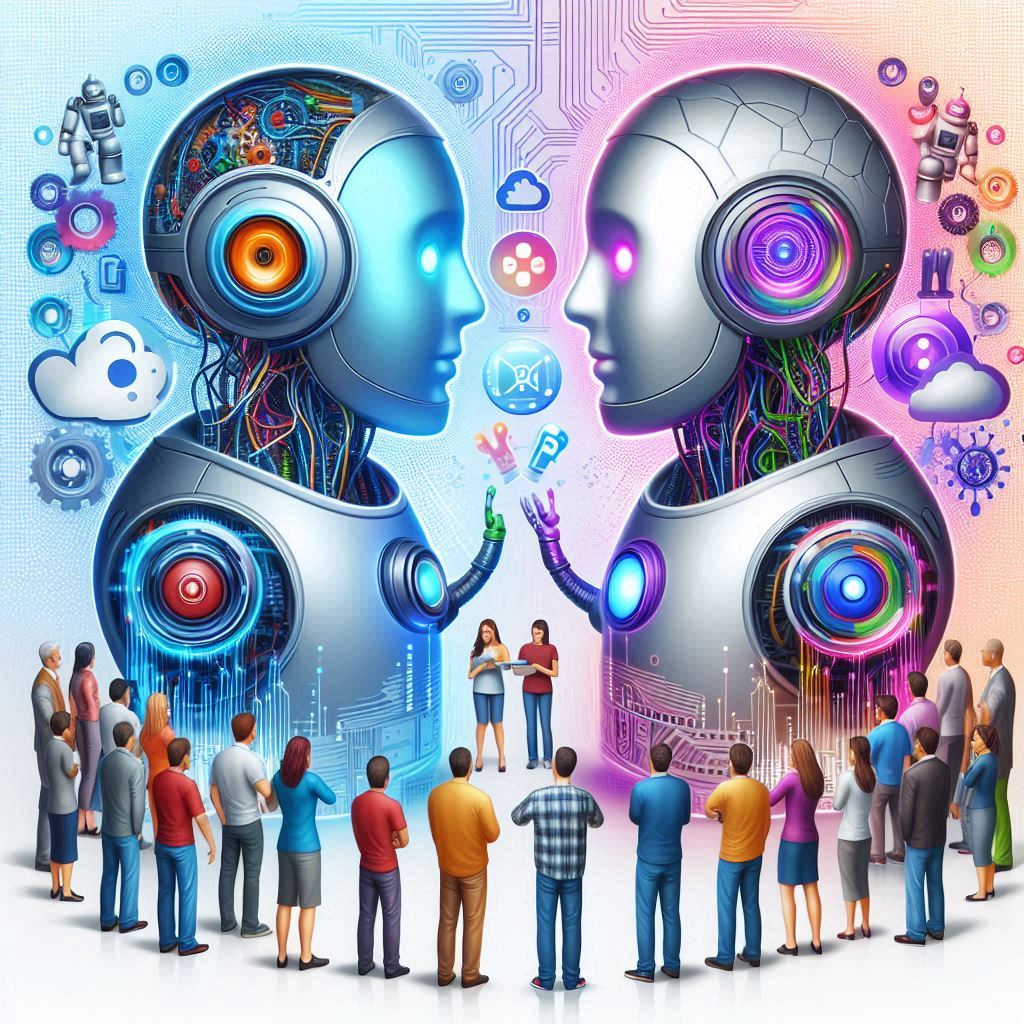 Why This Debate Matters
Why This Debate Matters
Artificial Intelligence (AI) is reshaping everything from healthcare and finance to AI recruitment tools and talent acquisition strategies.
As companies race to deploy AI-driven solutions, a central question emerges: Should these technologies be developed as open source or protected behind closed doors? The answer has significant implications for innovation, security, and trust—factors that deeply influence HR tech trends, recruiting software, and beyond.
In this post, we’ll provide a comprehensive analysis of Open Source AI versus Closed Source AI, including case studies on Deepseek (a successful open source platform), Grok 3 (a fully proprietary AI solution), and an “open washing” scenario.
By the end, you’ll be equipped to choose the approach (or mix of both) that best suits your goals, whether you’re focusing on mitigating bias in AI, safeguarding data privacy, or keeping pace with HR tech trends.
Defining the Two Models:
1. Open Source AI
Open Source AI involves making source code—and sometimes model weights—publicly accessible. Contributors from around the globe can inspect, modify, and improve these projects under licenses like MIT, Apache, or GPL.
- Collaborative Development
A broad community can rapidly fix bugs and propose enhancements, accelerating the pace of innovation. - Transparency & Trust
Publicly available code makes it easier to spot and address issues such as bias in AI, which is crucial for applications like AI recruitment tools. - Cost-Effective
Often free to adopt. While businesses may invest in premium support or custom development, the barrier to entry remains low.
Case Study: Deepseek (Open Source)
Deepseek is a new AI research platform embracing a fully open ethos. Its core algorithm, training datasets, and roadmap are available on GitHub, inviting worldwide collaboration. The project has attracted researchers, HR tech startups, and other innovators keen on building advanced recruiting software and analytics tools on a transparent foundation.
Key benefits observed with Deepseek include:
- Rapid Iteration: A global network identifies issues and adds new features in record time.
- Low Adoption Cost: Startups integrate Deepseek’s models without high licensing fees, making it an attractive option for talent acquisition software development.
2. Closed Source AI
Closed Source AI locks down its internal code and model parameters. Only the owning organization has full access, limiting external influence and visibility.
- Protecting IP & Competitive Edge
Proprietary AI often retains unique methodologies and data-processing techniques, particularly valuable in fast-moving sectors like AI recruitment tools. - Centralized Updates & Security
A single entity controls development, streamlining updates and fixes but limiting outside scrutiny or customization. - License Fees & Higher Costs
Typically involves purchase or subscription fees. Enterprise-level solutions can become costly, especially for large-scale deployments.
Case Study: Grok 3 (Closed Source)
Grok 3 is a next-generation AI known for its advanced natural language processing capabilities. Despite its effectiveness in resume parsing and candidate matching, Grok 3 remains fully proprietary, granting only limited API access to approved partners.
Advantages and challenges include:
- Specialized Innovation: A dedicated internal R&D team refines the algorithms for niche use cases like automated candidate filtering.
- Opaque Processes: Clients have limited insight into bias in AI or data privacy measures beyond what the vendor discloses.
The Phenomenon of “Open Washing”
What Is Open Washing?
“Open washing” occurs when an organization markets its AI product or platform as “open source” or “transparent,” yet withholds key components—such as datasets, core algorithms, or meaningful documentation.
- Partial Transparency
Users see some code or limited functionalities but can’t access the entire system, hindering true collaboration. - Misleading Perceptions
Audiences believe they have full control or insight, only to discover they’re still dependent on the vendor for advanced features or crucial integrations. - Eroding Trust
When uncovered, open washing can harm a brand’s reputation, especially in areas like HR tech trends or talent acquisition, where ethical and transparent practices are increasingly valued.
Case Study: Project Nova (Open Washing)
Project Nova launched with significant buzz, touting itself as an “open source solution” for AI recruitment tools. Initially, it shared a GitHub repository with modular code for basic data processing tasks. However, closer inspection by developers revealed:
- Locked Core Algorithm: The main AI engine remained encrypted, making it impossible to verify or alter critical decision-making processes.
- Missing Training Data: While the project claimed “full openness,” the datasets used to train the model were never published, raising bias in AI concerns.
- Undisclosed Licenses: The code in the GitHub repo used a permissive open source license, but some modules quietly fell under a restrictive proprietary agreement.
Consequences:
- Diminished Credibility: Early adopters felt misled, questioning whether the project’s decisions could be trusted—particularly around data privacy and unbiased candidate evaluation.
- Community Backlash: Developers looking to contribute discovered they couldn’t meaningfully enhance or audit the model. Many moved on to genuinely open alternatives.
Detailed Analysis: Open Source vs. Closed Source
Innovation & Collaboration
- Open Source
- Global Contribution: Skilled individuals worldwide can identify issues swiftly and propose new features.
- Community Support: Extensive user forums and documentation often exist, providing robust resources for everything from testing to real-world deployment in recruiting software.
- Closed Source
- Proprietary Breakthroughs: R&D teams can make specialized innovations without competing or conflicting community demands.
- Focused Vision: Feature updates follow a single internal roadmap, reducing project fragmentation.
Trust & Transparency
- Open Source
- Verifiable Code: Essential for sectors like talent acquisition, where companies must ensure bias in AI is minimized.
- Ethical Accountability: Public scrutiny drives adherence to ethical data usage and fair decision-making.
- Closed Source
- Opaque Algorithms: Clients rely on the vendor’s assurances and track record.
- Brand Reputation: Trust hinges on external audits, certifications, or demonstrated performance rather than direct code review.
Security & Control
- Open Source
- Peer Review: Security issues may be spotted sooner by a global network of testers.
- Fragmentation Risks: Forking can occur, potentially complicating version control and patch management.
- Closed Source
- Centralized Governance: A single organization manages security patches.
- Limited External Audits: Outsiders often can’t fix vulnerabilities themselves; they must wait for the vendor to address issues.
Cost Implications
- Open Source
-
- Low Initial Costs: Attractive for startups and academic labs, especially those exploring HR tech trends or building custom recruiting software solutions.
- Flexible Licensing: Choices like MIT, Apache, or GPL allow varying levels of commercial usage.
- Closed Source
- License & Subscription Fees: Often significant for enterprise deployments.
- Vendor Lock-In: Switching providers can be cumbersome if proprietary data formats or APIs are used.
Relevance to AI Recruitment Tools & HR Tech Trends
For organizations leveraging AI in talent acquisition—particularly in screening resumes, ranking candidates, or scheduling interviews—the open source vs. closed source debate directly impacts:
- Bias in AI
- Open Source: Transparent models allow external audits to identify and address any discriminatory patterns.
- Closed Source: Potential biases stay hidden, creating liability and reputational risks.
- Data Privacy
- Open Source: Clear documentation can bolster confidence, though organizations must still implement robust policies to protect personal information.
- Closed Source: Clients rely on the vendor’s assurance that privacy measures meet regulations and best practices.
- HR Tech Trends & Recruiting Software
- Open Source Flexibility: Allows rapid feature development and custom integrations that suit unique organizational needs.
- Closed Source Stability: Polished, proprietary solutions can be easier to deploy but may come with a higher price tag and less customization.
Market Trends & Statistics
The global AI market is projected to grow from $387 billion in 2022 to nearly $1.4 trillion by 2029, reflecting surging interest across sectors. In the HR tech and talent acquisition space:
- 65% of organizations either use or plan to adopt open source AI tools to accelerate innovation and reduce costs.
- 35% stick with closed source for perceived advantages in security and proprietary control.
- 78% of HR leaders voice concerns about bias in AI and data privacy, making transparency a top priority when evaluating AI solutions.
Making the Right Choice
Opting for Open Source AI or Closed Source AI is a strategic choice guided by:
- Innovation Goals: Do you value collective problem-solving, or do you need a controlled environment for specialized breakthroughs?
- Risk Tolerance: Can you handle the openness of your code and data, or do you require strict control?
- Compliance & Ethics: In regulated sectors or HR contexts, transparent practices and thorough auditing can be non-negotiable.
- Resource Allocation: Do you have in-house expertise to maintain an open source framework, or do you prefer the vendor-driven updates of closed source?
Hybrid Approaches—open sourcing certain components while guarding proprietary features—are also on the rise, marrying the benefits of communal collaboration with a measure of exclusivity.
Conclusion & Call to Action
The Open Source vs. Closed Source AI debate goes beyond technical details—it’s a pivotal choice shaping how we innovate, uphold trust, and address ethical considerations.
As AI-driven solutions like Deepseek (open source) and Grok 3 (closed source) demonstrate, both models have merits and trade-offs. The cautionary tale of Project Nova underscores the pitfalls of open washing, reminding us that partial disclosure can erode credibility and stall genuine progress.
Here’s how you can shape the conversation:
- Share this article with colleagues or stakeholders evaluating AI solutions for talent acquisition or other mission-critical use cases.
- Comment below on your experiences with open vs. closed source: What worked, what didn’t, and where do you see the industry heading?
- Stay informed on HR tech trends, bias in AI mitigation techniques, and data privacy regulations—these evolving standards can make or break AI-driven initiatives.
By engaging thoughtfully with the open source vs. closed source debate, you’ll be better equipped to harness the full potential of AI while ensuring ethical, secure, and transparent operations across the board.



